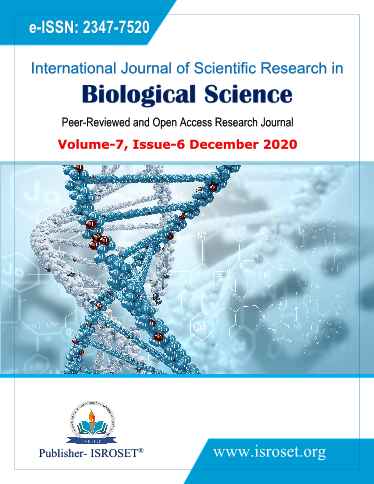Investigation of Weeds in Wheat Crops of Tehsil Kotli, Kotli Azad Jammu and Kashmir, Pakistan
Keywords:
Weed’s diversity, Kotli AJK, Wheat, Economy, Invasive Species, PartheniumAbstract
Weed infestation is one of the most drastic factors which adversely affects the grain quantity as well as quality in cereal crops like wheat, which is a worldwide cultivated staple food crop. The aim of this research was to survey the weed species found in wheat growing in tehsil Kotli. The survey was performed from seeding to harvest during the wheat campaign 2019-2020. Thirty one weed species belonging to twenty six genera and sixteen families were reported. Most weed species (26%) belonged to the Asteraceae family followed by Poaceae (13%), Brassicaceae (10%), Polygonaceae (10%) and Papaveraceae (6%). Other minor families found belonged to Amaranthaceae, Apiaceae, Caryophyllaceae, Cyperaceae, Euphorbiaceae, Lamiaceae, Malvaceae, Oxalidaceae, Primulaceae, Ranunculaceae and Saxifragaceae. Rumex genus was the most represented by four species followed by Cirsium, Fumaria and Lepidium. Controls of these weeds require awareness of farmers about the use of ecofriendly methods (i.e. physical, biological and crop rotation) in a weed integrated management.
References
PBS (Pakistan bureau of Statistics) http://www.pbs.gov.pk/
Memon, R.A, G. R. Bhatti, S. Khalid, A. Mallah and S. Ahmad., “Ahmed Illustrated weed flora of wheat crop of Khairpur district.,” Sindh. Pak. J. Bot., Vol. 45, Issue: 1, pp. 39-47, 2013.
Marwat, K.S., K. Usman, N. Khan, U. M. Khan, A. E. Khan, A. M. Khan and A. Rehman., “Weeds of wheat crop and their control strategies in Dera Ismail Khan District, Khyber Pakhtun-Khwa, Pakistan.” Am. J. Plant Sci., Vol. 4, Issue: 1, pp. 66-76, 2013.
Shabbir, A. and R. Bajwa., “Distribution of Parthenium weed (PartheniumhysterophorusL.): An alien invasive weed species threatening the biodiversity of Islamabad.,” Weed Biol. Manage., Vol. 6, Issue, 2, pp. 89-95, 2006.
Hassan, G. and K.B. Marwat., “Integrated weed management in agricultural crops.,” National Workshop on Technologies for Sustainable Agriculture, Sep. 24- 26, 2001. NIAB, Faisalabad, Pakistan. 2001.
Pimentel, D., R. Zuniga and D. Morrison., “Update on the environmental and economic costs associated with alien invasive species in the United States.,” Ecologic. Econ., Vol. 52, pp. 273-288, 2005.
A S. dkin, S.W. and S.C. Navie., “Parthenium weed: A potential major weed for agro ecosystem in Pakistan.,” Pak. J. Weed Sci. Res., Vol. 12 (1-2): pp. 19-36, 2006.
Shah, S. A. H., “An overview of Parthenium hysterophorus, with reference to Kotli AJ&K.,” International Journal of Scientific Research and Engineering Development., Vol. 3, Issue 1, page 7. 2020.
Sosa, A. J., M. V. Cardo and M. H. Julien., “Predicting weed distribution at the regional scale in the native range: environmental determinants and bio control implications of Phyla nodiflora (Verbenaceae).,” Weed Res., Vol. 57, Issue 3, pp. 193-203. 2016.
??, Shah Jahan & Ali Leghari, Umed & Laghari, Ghulam & Buriro, Mahmooda & Soomro, Farooque., “An Overview on Various Weed Control Practices Affecting Crop Yield.,” Journal of Chemical, Biological and Physical Sciences., Vol. 6, No. 1, pp. 59-69, 2015.
Shah, A.H., and R. Ali., “Exploitation of folk ethnomedicinal knowledge of Kotli Azad Jammu and Kashmir-Pakistan.,” Pak. J. Weed Sci. Res., Vol. 26, Issue 2, pp. 243-250, 2020.
Ali, S.I., Nasir, E., (Eds.) 1970–2002., Flora of Pakistan., 01-215.
Ali, S.I., Qaiser, M., “A phyto-geographical analysis of phanerogams of Pakistan and Kashmir.,” Proc. R. Soc. Edinb. 89B, pp. 89–101, 1986.
AJKMAPH (Azad Jammu Kashmir Medicinal & Aromatic Plants Herbarium) http://www.flora.parc.gov.pk/
DG (Dave’s Darden) https://davesgarden.com/
FoP (Flora of Pakistan) http://www.tropicos.org/Project/Pakistan.
NRCS (Natural Resources Conservation Service) http://plants.usda.gov/
Downloads
Published
How to Cite
Issue
Section
License

This work is licensed under a Creative Commons Attribution 4.0 International License.
Authors contributing to this journal agree to publish their articles under the Creative Commons Attribution 4.0 International License, allowing third parties to share their work (copy, distribute, transmit) and to adapt it, under the condition that the authors are given credit and that in the event of reuse or distribution, the terms of this license are made clear.







